- Chapter I: Rebranding without losing identity: How K16 redefines itself while remaining authentic
- Chapter II: Succesful rebranding: your 3-phase checklist
- Chapter III: The right tone sets the brand: Tone of voice in corporate communications
- Chapter III.1: Examples of successful tone of voice strategies
- Chapter III.2: AI and the tone of voice
- Chapter IV Claims and slogans in everyday life: Lighthouses or sources of confusion?
- Chapter V
- Chapter V.1 5 steps to brand-compliant documents in Microsoft 365
Introduction
Design is much more than aesthetics—it’s the visual language brands use to bring their identity to life and convey messages that resonate, even without words. In a rapidly changing world, maintaining a consistent and authentic brand presence is an essential anchor.
We had the opportunity to speak with Eibo Schulz-Wolfgramm, Managing Director and Founder of K16. He shares valuable insights on achieving successful rebranding without compromising identity, as well as how businesses can honor their roots while confidently embracing new directions. This conversation explores the delicate balance between innovation and continuity—and highlights what makes K16 stand out from other agencies.
Expanding on this, Professor Dr. Matthias Johannes Bauer explains how taglines and slogans can serve as impactful tools for refining and strengthening brand identity. Both experts underscore the critical role of strategic value frameworks in fostering authentic and distinctive communication over time.
How can a company continuously evolve and still remain authentic? K16, a leading B2B communications agency based in Hamburg, Germany, faced this very challenge. They kicked off 2024 with a rebranding. Over the course of more than 35 years, the company has reinvented itself several times—from digitalization partner to holistic consulting and design partner. But how do you stay true to yourself in an ever-changing industry?
We spoke with Eibo Schulz-Wolfgramm, Managing Director and Founder of K16. He’s been with the company since the beginning and takes us on a journey through multiple rebrandings, strategic transformations, and constant change. Is bold, edgy branding the key to success? And how do you balance old values with new strategies? Here’s an interview about the balancing act between innovation and consistency—and what makes K16 different from other agencies.

Eibo, you’ve been managing director of K16 for over 35 years. How many rebrandings has K16 undergone in that time?
Yes, I’ve been on board for exactly 35 years. I started in 1989 as a student. I’d say we’ve had at least four rebrandings. At the beginning, it was less about corporate design. You had a logo, a name, you picked a color and a font, and that was it. The corporate design approach we know today has evolved over time.
We’ve always tied our corporate design to major strategic changes and milestones, such as major moves. Those types of changes have generally led us to adapt our look to new circumstances. Basically, we’re fans of a fluid corporate design. Not everything needs to be set in stone. We need healthy guidelines within which creativity is possible. That’s always been our approach.
How would you describe the development of K16 over the years?
I’d like to begin this answer with our motivation: What drives us? We always strive for healthy growth. Many people reduce this to numbers. For me, growth also means growing with our employees, our customers, and their needs. We constantly face new challenges that help us grow—and our corporate design grows with us.
When we started, we were primarily a digitization partner for our customers. It was less about design and more about digitizing content. Our first clients—mainly consulting firms—were still working with overhead slides and colored markers. Then suddenly there was the ability to digitize text. For the first ten years of our company’s history, our approach was very service-oriented.
As trust grew, so did complexity. As the demands grew, so did the scope of corporate design and branding.
How do you stay true to the core of who you are on a journey like this?
There are certain core values that you carry with you, both as a person and as a company. This applies to the people in the company as well as our clients. No matter how we present ourselves in terms of design, at the end of the day we have to be true to ourselves, be human and not aloof. It’s ultimately about corporate identity: What values do we embody? How do we present ourselves to the outside world?
What brand values are most important to K16?
We’ve developed a set of values that guide us: down-to-earth, partnership, responsibility, and honesty. These four values are particularly important to us and shape our actions, both internally and externally.
Being down-to-earth may seem boring and uninnovative at first, but it’s critical to truly understanding our clients’ problems and needs.
Partnership means working with our clients—the people—as equals, without hierarchical barriers. We live this partnership not only externally, but also internally by truly caring about the people who work at K16—not just their roles or functions.
Responsibility and honesty go hand in hand. We often deal with confidential client information, which requires the highest level of discretion. In addition, our clients expect us to act responsibly and always do what’s best for them.
What makes K16 different from other agencies? How do you create a unique brand identity?
Everything and nothing, to put it in a nutshell. If you just look at our portfolio, you might think we’re not much different from other agencies.
But we make our customers feel good by truly living our values. For example, some clients call us at 9 p.m. in urgent situations. They know that even in stressful situations, such as before an important event, we’re there to help. Quality and partnership are always our top priorities. Beyond the usual range of services, we take a holistic, often challenging view of our clients’ projects, which has made us a consulting partner. We’re down-to-earth and honest.
Can you give us an example?
We often get requests for a new PowerPoint slide master. However, many times it turns out that the customer needs something completely different. We always try to look at the entire customer journey.
Even if it’s just the slide master, a comprehensive service chain is needed to successfully implement it in the company. The slide master is always a good foundation, a good platform. But how do you communicate the rules or possibilities of the design to the users? Together with our clients, we create guidelines so that all users in the company can immediately communicate within the branding using the new slide master.
This holistic approach and willingness to question requirements makes us a valuable partner for our customers.
»We’ve developed a set of values that guide us: down-to-earth, partnership, responsibility, and honesty.«
Why did you decide to re-brand K16?
The rebranding is closely linked to our strategic transformation. We realized that we needed to communicate more precisely and clearly what services we offer in what areas—our so-called “excellences”.
It was a strategic decision to position ourselves more clearly in the market. As part of this process, it was a logical step to revamp our look and feel. Adjusting our strategy ultimately led to a new brand image.
How do you communicate your values through corporate design?
Corporate design must reflect a company’s values. Companies, their customers, and their employees should ask themselves: where does my design come from?
For me, it has to come from a content-based, strategic, value-driven world to be authentic.
Can you explain that?
Our primary color has always been red. However, in our previous image, we relied heavily on orange and mint green as secondary colors. That led to an inconsistent look to the outside world. As part of our corporate design adjustment, we refocused and made a clear commitment to our primary colors of red, black and white.
We spent a long time trying to find the right shade of red. How positive and bold should it be? How deep should it be to reflect our brand values? It was an intense process. I think our red is perfect for us. It’s striking and memorable. It has a positive energy that describes us well. We also use this color to make strategic accents in our corporate design.
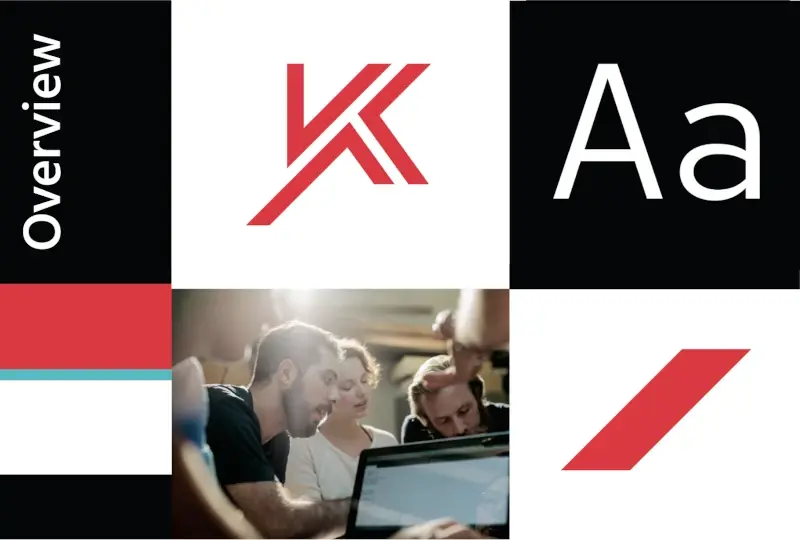
What’s behind the new K16 logo?
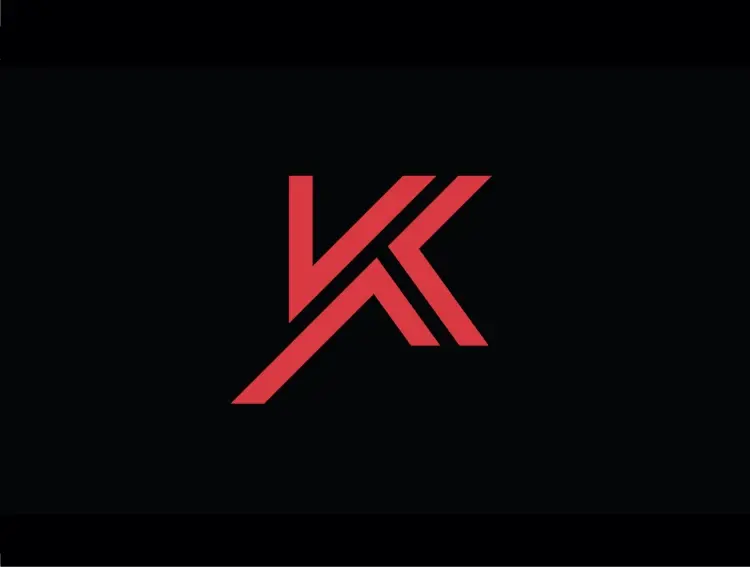
I’m particularly proud of the development of our logo. We don’t have just any random logo. It’s important for a logo to tell a story. And that’s exactly what our new logo does. The abstract “K” stands for our three “excellences”.
A central element of our rebranding was to present ourselves as a bold and creative sparring partner. We also focused on dynamic content and changed the way we interact with form and space. Our clients are often on the big stage and love things to move. Our new look is bolder, louder, and edgier. That was our goal.
How is increasing digitalization affecting the redesign of your corporate design?
Today, nothing works without digitalization. It’s almost become an overused buzzword.
Corporate design used to be simpler because it only had to be defined for a few channels—mostly print. Now we have to make sure it works across many different channels, especially digital.
The bottom line is that digitalization plays a critical role because we serve far more channels today than we did 10 or 20 years ago.
Did you use outside help to implement your rebranding?
Yes, we brought in external partners for the basic elements of our new corporate design. It was exciting for us to get a fresh perspective from the outside. A lot of times you get stuck in your own ecosystem and you’re relying too much on what you already know. What we wanted to know was: How do people who don’t know us see us?
With our partners, we tested different mock-ups and asked questions: How well does the design work across channels? How can it be staged? That allowed us to evaluate colors, typography, and shapes.
The entire process was collaborative and took several months. It’s a decision-making process that’ll shape the next few years. It should never be done ad hoc or on a whim.
»Another hallmark of a successful rebranding is that employees identify with the new look and feel proud to represent it.«
Were employees involved in the rebranding process? If so, how was it done?
Yes, the entire process was accompanied by an project group that included both K16 management and subject matter experts.
What was that like?
The project group was an important player. They provided valuable insights and challenged the outside view: what is K16 and what is it not?
The development process and the core values of the new corporate design emerged from this close collaboration. Finally, individual teams were also involved in the implementation of the various channels to bring the corporate design to life.
What are the key success factors for a successful rebranding?
Every rebranding needs a strategic foundation. Ultimately, it’s about the interplay of the core elements of corporate design: typography, shape, color, logo, and tone. These elements must harmonize. From the client’s perspective, it often sounds simple, but it’s a complex process that should be continually re-evaluated.
Another hallmark of a successful rebranding is that employees identify with the new look and feel proud to represent it.
It’s important to maintain some continuity for existing customers. A completely new look can be risky. That’s why it was important for us to emphasize: we’ve always been red, and we’ll always be red.
Color, font, imagery, etc. What do you think has the biggest impact on brand perception?
Color is very important to me. Our choice of red was a very conscious and color-psychological decision. But in the end, it’s the interplay of all the elements that counts. When we chose the typography, I was thrilled. Taken out of context, it might be judged differently. But in the overall context, the choice of typography was correct and consistent.
So I wouldn’t emphasize any single element. It’s the harmonious interplay of the core elements that creates a strong brand presence.
What are the trends in corporate design that you see for 2025?
A mega-trend that’s affecting all areas—including corporate design—is artificial intelligence (AI). AI can be used to develop corporate design, collaborate on designs, analyze target groups, and much more. It would be a big mistake not to use AI for corporate branding and design. Especially in the field of visual worlds, AI offers many possibilities.
I also believe in simplicity. Simple designs with a high recognition value that stick in people’s minds. Bold, eye-catching, and not too playful. In a world flooded with messages and visuals, we should focus on the essential core elements of the brand and implement them creatively across channels.
But in the end, it all comes down to values. A company’s external image must reflect its internal values. Corporate design needs a strategic basis. Represent what you are, what you can do, and what you stand for.
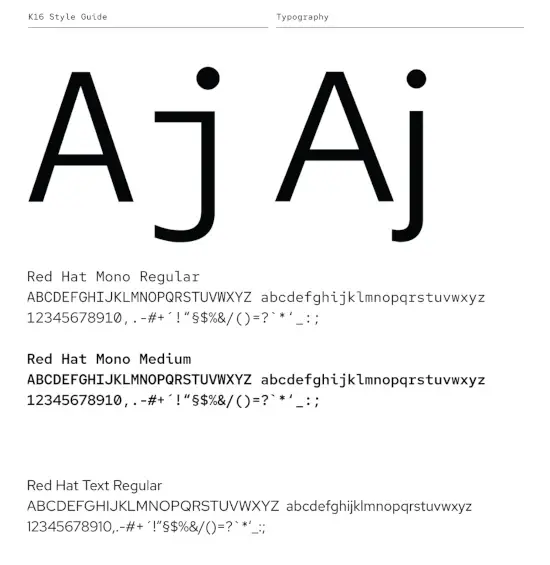
Brands are constantly challenged to adapt to changing market conditions. While it may be difficult to revamp an established brand, rebranding can help future-proof the brand, meet the needs of the target audience, and build stronger customer loyalty. With a clear structure, this complex process can be managed more efficiently. The following checklist serves as a guide to ensure you consider the essential steps.
Phase 1: Researching and planning
1. Assemble the rebranding team
- Involve both internal and external stakeholders who can assess how different groups will respond to the rebranding.
- Assign clear roles and responsibilities to team members.
2. Perform market analysis
- Analyze market changes, industry trends, and shifts in customer expectations.
- Create a competitive analysis and SWOT analysis to determine your market position accurately.
3. Refine buyer personas
- Conduct a detailed analysis of your target audiences. If your audience has changed or new groups are being targeted, adjust your personas accordingly to align the rebrand with current personas.
4. Determine brand elements to retain
- Rebranding doesn‘t automatically mean changing everything. Decide which brand elements you want to keep to preserve recognition after rebranding.
- Create a list of brand elements that need to be updated or optimized.
5. Decide on the type of rebranding
- Determine if a simple brand refresh, partial rebrand, or complete overhaul is needed.
6. Set a timeline and milestones
- Develop a timeline and set realistic milestones to avoid delays.
7. Gain executive buy-in for rebranding strategy
- Create an implementation plan that details the transformation and the required budget, and get it approved by senior management.
Phase 2: Update existing assets
1. Review mission and values
- Update your company mission and values as needed to reflect the brand updates.
2. Review logo
- Consider whether a new logo is needed or if the current logo needs minor adjustments. Don‘t rush into anything, as the logo is an important recognition and trust factor.
3. Review slogan
- Decide if your slogan needs to be adjusted or if it still fits the new brand.
4. Review brand colors
- Adjust your brand colors, if necessary, to properly represent the new brand.
5. Revise brand guidelines
- Update your brand guidelines and make sure all stakeholders have access to them.
Phase 3: Present the new brand identity
1. Keep teams up to date
- Announce the rebranding internally and regularly update your teams on progress to foster a positive attitude toward the rebranding.
2. Update website
- Align your website with the new brand identity, including colors, layout, logo, and “about us” page.
3. Communicate rebranding internally and externally
- Announce the rebranding internally and inform the public through targeted social media posts and emails to your customers.
In brand communication, it’s not only what you say that counts, but how you say it. Companies that want to differentiate themselves from the competition over the long term need to craft messages that inspire trust and excitement in their target audiences.
A key component of these messages is tone of voice—the specific style of communication that determines how the brand is perceived. It’s about much more than words: it’s about the recognition, authenticity, and trust that comes from consistent and credible communication. It’s about sounding like your company.
But how can you put tone of voice into practice to convey your company’s values and identity? And what’s the role of artificial intelligence (AI) in this context?
The building blocks of the tone of voice: from word choice to emotion
An effective tone of voice is made up of several elements that work together to create the brand’s voice:
- Word choice (lexis): The terms and phrases used determine the impression a brand makes. This can range from technical precision to emotional terms and colloquialisms. It also determines whether short, concise phrases or longer, more complex expressions are preferred.
- Sentence structure (syntax): Short, concise sentences come across as accessible and direct, while complex sentence structures often signal formality and seriousness.

- Tonality (emotional nuance): The emotional undertone determines whether the message comes across as friendly and approachable or factual and authoritative. This contributes significantly to how a brand is perceived on an emotional level.
What is tone of voice and why is it essential?
Tone of voice describes the tone of a company’s communication. It influences how the target audience perceives the company and contributes significantly to branding. It includes word choice, sentence structure, and the emotional nuance that resonates in every message. A humorous and relaxed tone conveys a very different brand image than a distant and formal communication.
Tone of voice creates coherence and ensures that a brand is consistent across all channels. This allows companies to build trust and develop a close relationship with their customers.
Making brand values tangible: how to translate identity into language
Brand values are at the heart of every corporate identity, and tone of voice makes those values audible and tangible in every message.
1. Clearly define your brand values
What’s your mission? What defines your brand? What values are central to your identity? These need to be articulated clearly and unambiguously so they can be translated into communications.
2. Translate brand values into language
Use your brand values as a basis for word choice and tonality. Every choice of language should reflect these values.
3. Adapt to audiences and context
While the tone of voice should remain consistent at its core, it must be flexible enough to adapt to different audiences and communication channels. Consistency is not stagnation.
4. Storytelling as a value communicator
Tell stories that make your brand values tangible. Tone of voice determines how these stories are told and how the audience receives them. For example, a company that has social responsibility as a core value might tell stories about its charitable projects and choose an empathetic and engaging tone.
Translating brand values into language: Deutsche Post
Deutsche Post implements its tone of voice using four values that reflect its committed, people-oriented spirit:

Practical and consistent
Deutsche Post sees itself as a facilitator and uses positive and constructive language. “Of course I’ll find out for you.” The focus is on trustworthiness—people entrust Deutsche Post with private and valuable information. The language conveys that personal data and concerns will be treated securely and confidentially. “You can trust us.” The company also comes across as confident, but not arrogant. “We can help you; that’s what we’re here for” instead of “Trust me, I know better.”
Human and approachable
Customers are addressed personally whenever possible—by name or directly as “you”. Impersonal terms such as “people” are avoided to create a sense of intimacy. The senders of the messages are also clearly identifiable to foster a personal dialogue.

Respectful and credible
The company makes a point of taking customers and their needs seriously. The pronoun “we” is often used: “We can solve this together.” Criticism is accepted openly and responded to with empathy. In order to convey credibility, superlatives are used sparingly and advertising statements are clearly explained without “small print”. “Our services are subject to factors beyond our control” instead of “We guarantee delivery by noon tomorrow. Fastest service, lowest prices!”
Contemporary and optimistic
To be understood by everyone, Deutsche Post uses simple and clear language without unnecessary jargon. It also avoids excessive introductions, filler words and empty phrases. Services are explained in an understandable way, without being preachy or salesy, but with clear recommendations and benefits. “Product X benefits you personally because...” instead of “Buy this! Act now!”
Tone of voice consistency: tips for a consistent brand voice
Consistency is critical to successful brand communication. Once a tone of voice is established, it must be maintained across all channels and in every message to build brand recognition and credibility.
Tips to help you stay consistent:
- Tone of voice guide: Establish clear guidelines for your tone of voice. This guide should outline how your brand speaks on different channels and what words, sentence structures, and tonalities are used. Do’s and don’ts make this particularly tangible.
- Training and workshops: Ensure that everyone involved in communications understands and can apply the tone of voice. Training helps ensure consistency.
- Regular review: Regularly check that your communications are following the established guidelines. This can be done through internal audits or external feedback loops. You may also need to establish KPIs to measure the quality and consistency of your communications.
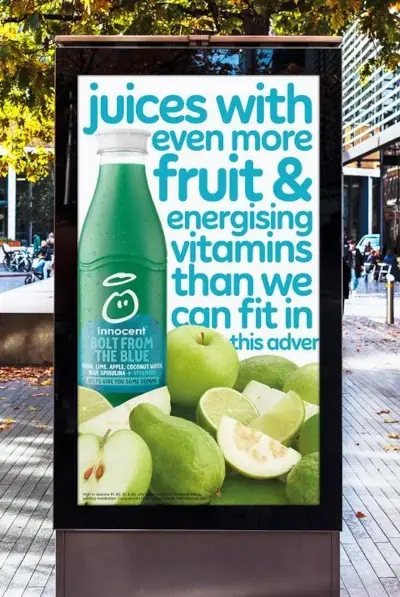

- Digital tools: Tools such as content management systems or text analytics software can help monitor and maintain tone of voice consistency.
- Lead by example: Managers should lead by example and actively model and support the tone of voice. A strong role-model function and regular communication of the importance of the tone of voice as part of the brand identity strengthens compliance and motivation within the company.
Innocent - relaxed and humorous
Innocent Drinks, the manufacturer of smoothies and juices, is known for its humorous and relaxed tone. Their language is relaxed, often playful, without losing sight of their core values of health and sustainability. They use simple, accessible language that exudes authenticity and humanity, creating a strong connection with their target audience. Their social media posts often use puns and speak directly to their followers. Product packaging also features tongue-in-cheek descriptions that make the brand feel relatable and human.

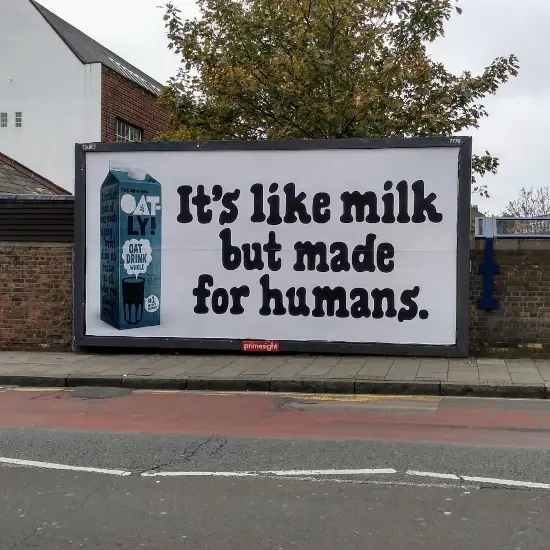
Oatly - provocative and ironic
Oatly, the Swedish oat milk company, uses a provocative and ironic tone that stands out from typical brand communication. Their style is honest, unconventional, and at times deliberately provocative to stimulate discussions about sustainability and nutrition. On the packaging, Oatly takes a “talking” approach, where the packaging “talks” directly to the customer and makes ironic comments. Their advertising campaigns often use bold and provocative statements such as “It’s like milk, but made for humans.”
The use of artificial intelligence (AI) can greatly simplify corporate communications
AI is especially useful when it comes to processing large amounts of data, automating standard responses, or personalizing content. However, it’s wise to consider whether and how AI may simplify and streamline corporate communications.
AI is valuable for simple, recurring tasks such as answering FAQs or confirming appointments. However, in emotionally charged or creative contexts, the focus should always be on a human connection.
To ensure that the AI strikes the desired tone of voice, a number of measures are recommended:
Training the AI
An AI can learn to reproduce a company’s tone of voice if it’s trained with enough sample texts that clearly reflect the style and tone. Companies should ensure that they provide a wide range of content to train the AI in different communication contexts.
Fine-tune through parameters
Modern AI tools, such as GPT-based models, make it possible to preset certain parameters for tone and style. This allows companies to control how formal, humorous, or objective the AI content should be. These parameters help to achieve the desired emotional nuances and maintain brand identity, even in automated texts.
Continuous monitoring and adjustment
Even if an AI can do much of the work, content must regularly be reviewed by humans to ensure that it hits the intended tone and that there are no misunderstandings. Especially in emotional or critical communication situations, human fine-tuning is essential.
The challenge is to find the right balance between efficiency and authenticity without losing the human touch.
Conclusion
A strong tone of voice is essential to communicate a company’s identity clearly and consistently. It conveys brand values, builds trust with the target audience, and creates recognizability. While the use of AI brings many benefits, companies should ensure that their communications never lose their humanity and authenticity. Ultimately, tone of voice remains a key element in the long-term success of a brand.
Claims, slogans, and now hashtags have become an integral part of brand communication. From “Red Bull gives you wings” to “I’m lovin’ it” to “Just do it”, countless messages bombard us every day.
But to what extent do these brand elements stick in our minds and provide real guidance? When do they cause confusion or get lost in the noise? In this interview, Prof. Dr. Matthias Johannes Bauer explains the role of claims, slogans, and hashtags in brand communication and what it takes to make them successful.

Matthias Johannes Bauer has a PhD in German Studies. He’s an economist and heads the Master’s program in Communications Management at the IST University of Management in Düsseldorf. His research and teaching focus on brand management with claims and digital communication with hashtags. He recently published a revised and expanded edition of his book “Claims, Slogans, and
Hashtags as Tools of Strategic Brand Management”.
What is your fascination with claims, slogans, and hashtags?
They combine several aspects. These branding elements are highly condensed, artistic, linguistic creations. This appeals to both the linguist and the communications manager in me. It’s also a relatable topic for lectures, presentations, etc. because everyone encounters it every day and finds it interesting to some degree.

What's the difference between claims and slogans in terms of use and effect?
This distinction is made primarily in German-speaking marketing research. Internationally, and in trademark law or advertising language research, this distinction is often not recognized. It’s important to note that the distinction depends heavily on the context. Here’s a helpful rule of thumb: a slogan is a linguistic tool for addressing customers directly, often through advertising headlines. A brand claim, on the other hand, communicates a brand’s core strategic idea—what the company “claims” for the brand. It positions and shapes the brand’s image through its pointed phrasing.
»A slogan is a linguistic tool for addressing customers directly, often through advertising headlines.«
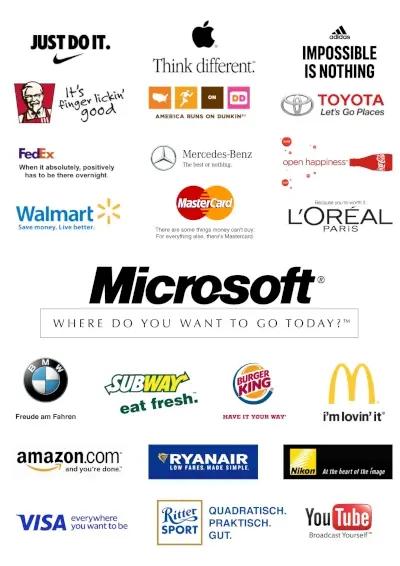
Claims and slogans, like the logo and other visual elements, are central to a brand’s positioning. They’re succinct representations of a brand’s core values and uniqueness, making them as integral as the brand name itself.
»Companies should choose a claim that is right for them and, ideally, that can be trademarked.«
I wouldn’t recommend it. The goal is for brands to be perceived as coherent and authentic, and thus recognizable. The tone of voice, the tonality of the brand, should be the basis for claims, slogans, and hashtags alike.
It’s less about whether a claim is good or bad, and more about whether it’s effective and appropriate. Companies should choose a claim that is right for them and, ideally, that can be trademarked. It’s better to have no claim than a bad or irrelevant one. Too often, companies rely on clichés or empty phrases that offer no unique value. A claim must communicate something distinctive and memorable, as it represents the brand’s unique selling point and should appear credible and coherent.
What linguistic devices do you find most effective for claims and slogans?
There’s no universal answer. Some devices are more memorable than others. Word play can help, although I wouldn’t recommend it for a funeral home unless it’s a deliberate strategy to approach a taboo subject in an unconventional way. Ultimately, it depends on the overall brand positioning strategy.
When and where should a company use a claim or slogan?
This isn’t a one-size-fits-all question. Each company must decide which brand elements to prioritize, whether it’s the brand name, logo, jingles, colors, fonts, or even packaging. Companies often make the mistake of creating claims and slogans “on the side”, which I strongly discourage.
When is it too much, given the number of brand messages we receive every day?
A company can’t cut back on communication to avoid overwhelming customers while competitors remain highly visible. But “the more the better” isn’t a good strategy either. Quality over quantity is the key, with a focus on consistent and strategic communication that respects people’s time and attention.
What needs to be considered to make brand communication stand out from the daily noise?
A clear brand identity and emotionally resonant messages tailored to the needs of the target audience will help you break through the noise. All brand elements should be strategically planned and aligned.
When should companys adjust their claims and slogans?
A good slogan can last for decades, like BMW’s “Sheer Driving Pleasure“, which has been around since the 1960s! Strategic adjustments usually occur with new corporate brands, product brands, repositioning, or brand changes. Campaign claims naturally change with new campaigns, and slogans tend to have a shorter lifespan.
Compared to traditional slogans and claims, what role do hashtags play in brand communication?
Communication has become increasingly digital in recent years. Claims and slogans are often used as hashtags alongside other hashtags. Strategic alignment is essential as hashtags work differently to claims and slogans. I recommend that companies create a dedicated hashtag pool that is aligned with their strategy.
How can a company build an effective pool of hashtags?
This is a more complex process, starting with internal and external audits and answering various questions. For example, what product features suggest relevant hashtags? Or what hashtags are the competition using? The result should be a list of readily available, strategy-aligned hashtags that aren’t already in use.
What current trends do you see in the use of hashtags in marketing? What future developments do you see for slogans, claims, and hashtags?
As we see with brand names, developing new, concise names is becoming increasingly difficult due to the sheer number of brands. Claims and slogans can face a similar situation, so a thoughtful strategy and professional guidance is essential in the claiming process.
Can you give an example of a particularly successful claim or slogan? Which one is your favorite and why?
In Germany, “geiz ist geil” (cheap is cool) is a widely accepted statement. From a professional perspective, it’s excellent because it offers numerous interpretations, from the seven deadly sins to the history of the word “geil” (cool, sexy, hot...) . It’s subtly provocative.
Another example of a best practice is the German phrase “umparken im Kopf“ (repark your mind). Opel used it to strategically reposition itself and successfully create a new brand image.
It‘s well known that a strong brand inspires confidence and trust. This requires consistent messages and a clear corporate design at all touch points. However, the importance of business documents is often underestimated.
Nowhere do employees have a greater impact on your brand than when they create business documents, presentations, and emails. However, brand managers face a problem: documents and presentations often violate brand guidelines rather than adhere to them.
This is understandable because employees aren’t design experts, and Microsoft 365 doesn’t provide functional support for implementing corporate design guidelines. Instead, there’s almost complete creative freedom in Microsoft 365 applications, coupled with limited knowledge and understanding of guidelines among users. As a result, brand-inconsistent documents are regularly and uncontrollably distributed.
But what does this mean for consistent brand communication, and how can the brand potential of document creation be unleashed? We‘ll explore this in more detail below.
The impact of inconsistent brand communication
Prospects and customers often experience a company through multiple touchpoints. They see many different pieces of media, but it‘s the sum total that creates the overall impression.
The more consistently a company communicates, the more powerful the message. Repeating the same message increases its persuasiveness. The quality of a company’s communications is often seen as a measure of the quality of its services.
If the level of inconsistency in branding in presentations and documents is noticeably higher than in other media, viewers will notice this difference, which can weaken and even reverse a previously positive impression of the company.
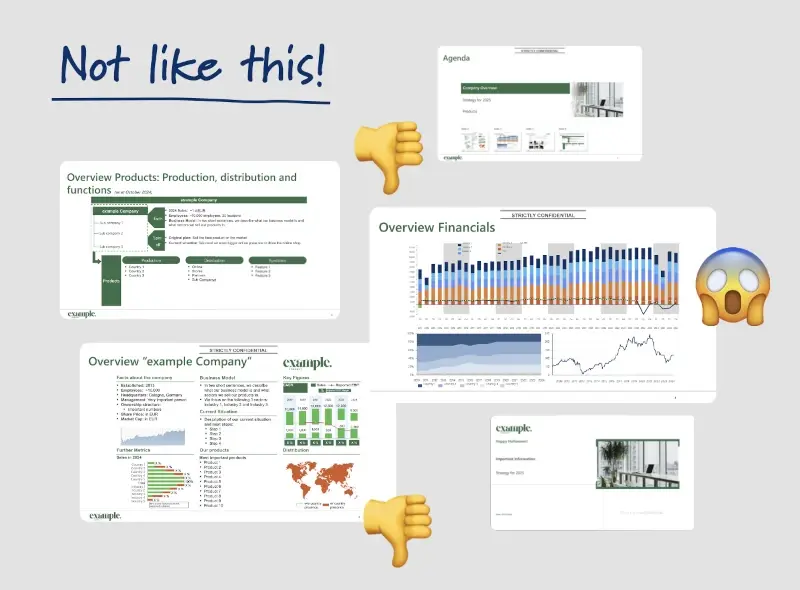
Business documents, such as those created with Microsoft 365 applications, are some of the most common communication tools in everyday business. Think contracts, proposal presentations, monthly reports, emails, and more. These documents are created and sent in bulk every day. Each of these documents represents your brand—for better or worse.
Remarkably, nearly 50% of the content created with Microsoft 365 isn‘t brand-compliant. This isn‘t surprising, as maximum design freedom typically confronts minimal design expertise. There’s a lack of effective controls for creating brand-compliant documents and a lack of recognition for adhering to brand guidelines. Nowhere is the potential and impact of employees on the brand image greater than in the creation of business documents.
Ideally, consistent and properly branded documents convey professionalism and trust, and integrate seamlessly with your communications and branding.
But how do you create brand-compliant documents and presentations in Microsoft 365 without compromising the efficiency of your day-to-day business?
Simple tips can be implemented using native Microsoft tools.
5 steps to brand-compliant documents in Microsoft 365: 1. Bring your brand into the game from the start
Make sure your current template opens automatically when you open Microsoft Office applications. For example, work with your IT department to ensure that the current master template opens when PowerPoint is launched. That way, people start with the right foundation without having to search for it.
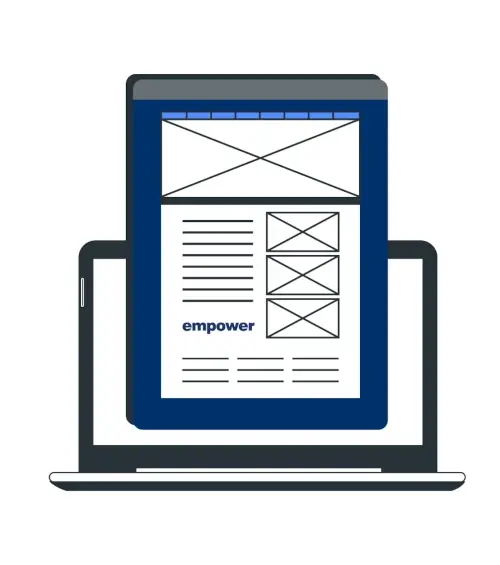
2. Deliver all brand assets directly in Microsoft 365
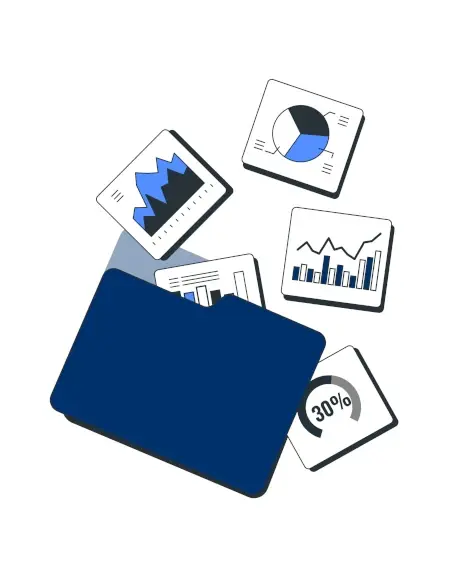
Images, icons, slide templates, and table and chart templates should be available directly in Microsoft 365. A SharePoint solution can be implemented using Microsoft‘s native tools: a library of all relevant images, presentations, icons, etc. can be created. This library can also be made available to users less familiar with SharePoint through a Microsoft Teams channel.
However, as of Office 2013, integrating the SharePoint slide library into PowerPoint is no longer a standard feature and requires specific steps.
3. Embed your corporate design guidelines in Microsoft 365
Even the most carefully crafted brand guidelines are only as good as the people who apply them. And this is a common problem in many organizations. Many employees are unaware of internal brand guidelines, while others ignore them due to time constraints, convenience, or feeling overwhelmed.
To prevent this, corporate colors and fonts can be embedded in Office applications using standard Microsoft Office features with the support of IT.
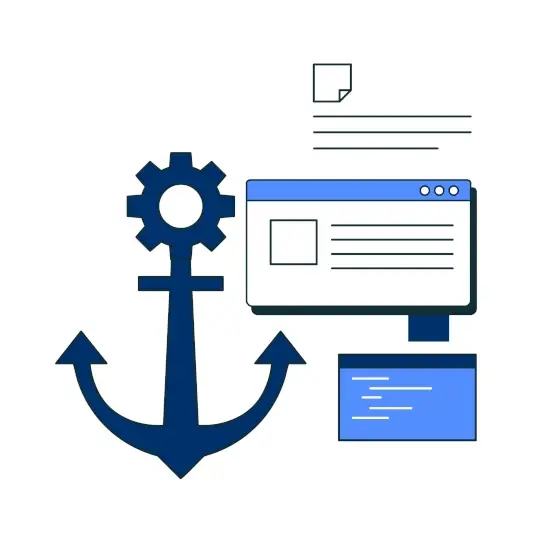
4. Simplify the transition from old to new
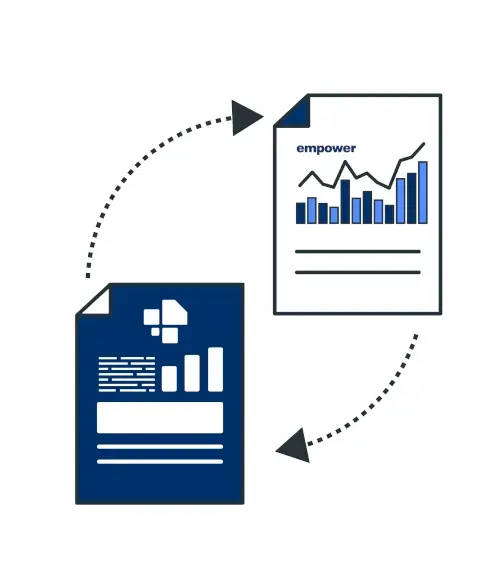
5. Review each document before sending
Especially when sharing Word or PowerPoint documents externally, it’s important to review them for accuracy and compliance. This can be done by the marketing or branding department or by a dedicated team. Given the sheer volume of Office documents created every day, this is almost impossible to manage manually. Often, there’s a lack of understanding of, and the importance of, brand consistency in Microsoft 365. That poses challenges to setting up an effective brand-control unit.
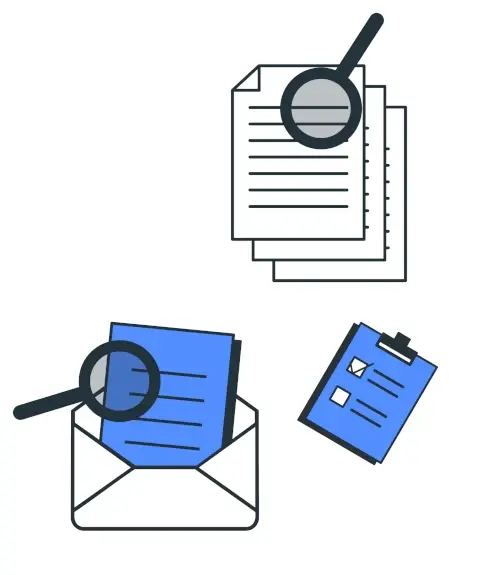
Invest in additional software: yes or no?
Microsoft‘s native tools for branded content creation have their limitations.
Microsoft 365 is productivity software for a broad audience, not branding software. Using additional software can be beneficial.
However, the decision to invest in such software is often difficult due to the additional costs involved and varying perceptions of the value of brand compliance. Organizations need to assess how critical brand compliance in Microsoft Office documents is to their business success.
Consider the following to help you make decisions about additional software for Microsoft 365:
- How many hours per week are spent using Microsoft 365 applications?
- How many presentations, documents, and emails are created and sent each week?
- How relevant is the information in the presentations and documents?
- How many people are the presentations and documents being sent to?
- How common are brand violations in presentations, documents, and emails?
- How complex are your brand guidelines?
- How flexible are the brand guidelines?
- How important are brand-compliant documents and presentations to your management?
- How important is consistent branding to your business success?
The importance of optimizing brand compliance escalates considering the more content you create with Microsoft 365, the more complex your policies, the more violations that occur during document creation, and the more important a brand-compliant look is to your business success.
As mentioned at the beginning, it’s the overall impression created by the sum of individual brand touchpoints that matters. And one of those touchpoints is business documents, which are typically created and shared in large volumes.
Additional software simplifies the creation of brand-compliant business documents. It integrates brand guidelines and templates directly into Microsoft 365. Brand assets are managed in a central library, allowing users to insert them with a single click from Office applications or convert existing content to a new design.
With these tools, users can review documents with a single click before sending. Deviations are identified and can be automatically corrected.
Furthermore, the software enables branding or marketing departments to manage brand assets without IT support.
In short, it ensures that business documents fit seamlessly into the brand image.
More from our Blog
Practical Office tips, inspiring stories, and market research on PowerPoint & Excel.

Brand relaunch: Common mistakes and how to avoid them

Interbrand Report 2025 – Why brands will be chosen, not just found


